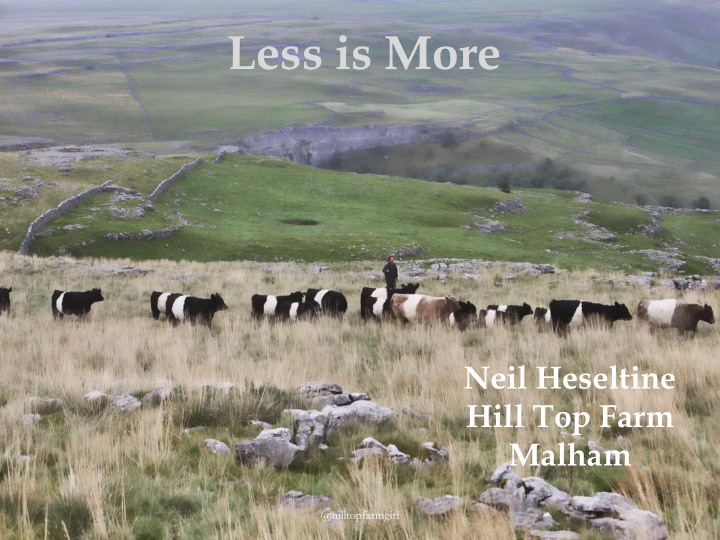



Less is More Neil Heseltine Hill Top Farm Malham @hilltopfarmgirl
Hill Top Farm @hilltopfarmgirl
HILL TOP FARM • Live & work at Hill Top Farm, Malham; • 300 acre family farm, Grandparents moved here in 1950 as tenants; • Parents bought it in 1980; • Parents converted cow shed to bunk barn accommodation in 1987; • Leigh runs family holiday cottage and bunk barn; • Cattle reintroduced 2003. @hilltopfarmgirl
HILL TOP FARM • Built up to 1100 acres, split between Malhamdale and Littondale; • Bought 200 acres; • 500 acres rented from private landlords; • 100 acres rented from National Trust; • All Less Favoured Area (LFA); • All Severely Disadvantaged; • All limestone permanent pasture; • All under HLS/ELS schemes; • Heights ranging between 800- 1800ft above sea level. @hilltopfarmgirl
SOCIAL MEDIA @hilltopfarmgirl
HILL TOP FARM • 400 Swaledale ewes; • 300 crossed with BFL ram; • 100 bred pure to Swaledale ram; • Dipping, clipping, dosing, scanning; • Lambing in mid March; • Ewes fed concentrates over winter and spring; • Wethers sold as stores/fat by end of August; • Mule gimmers sold for breeding in September; • Lambs creep fed through summer. @hilltopfarmgirl
LOCAL CHAMPION MALHAM SHOW 2013 THE TUP – NOT ME @hilltopfarmgirl
HILL TOP FARM • 20 Belted Galloway breeding cattle introduced in 2003; • 120 in total; • Hardy native breed; • Out wintered on the hill, fed hay in adverse weather conditions; • Extensively managed; • Low labour input; • Entirely grass fed; • Conservation grazers • Improve biodiversity and wildlife habitat @hilltopfarmgirl
WILDLIFE HABITAT Photo by @neil_bilsborough Photo by Brian Rabbitts @hilltopfarmgirl
WILDLIFE HABITAT @hilltopfarmgirl
BIODIVERSITY - PLANTS @hilltopfarmgirl
HILL TOP FARM SHEEP CATTLE • Higher output • Lower output • High feed costs • No purchased feeds • Labour intensive • Minimal intervention • Environmental Impact • Increased biodiversity • Marketed as a • Marketed as a commodity premium product • Regular • Zero routine treatments worming/vaccination programme @hilltopfarmgirl
HILL TOP FARM 2012 COSTINGS SHEEP CATTLE • £17,828 • Sales £59,318 • Labour £12,000 • £ 1,755 • Feed £15,178 • £ 270 • Haulage £ 320 • £ 668 • Other costs £11,202 • £ 3,675 • Livestock purchases £18,900 • £ 220 • Vets costs £ 1,240 • £ 6,588 • Total £58,840 • £11,240 • Contribution to drawings £ 478 @hilltopfarmgirl
HILL TOP FARM SHEEP Replicate the lessons we have learnt from the cattle enterprise: • The right breed for the right situation • Allow sheep to exhibit natural behaviour To achieve this? • Breed is crucial • An extensive system – reduce breeding ewe numbers to 200 • Lambing in late April, early May @hilltopfarmgirl
HILL TOP FARM CURRENT COSTINGS SHEEP CATTLE 2012 2016 2016 2012 £ £ £ £ 17,828 21,310 • Sales 32,081 59,318 1,755 1,260 • Labour 750 12,000 270 500 • Feed 3,724 15,178 668 0 • Haulage 0 320 3,675 1,318 • Other costs 2,600 11,202 220 3,040 • Livestock purchases 7,042 18,900 117 117 • Vets costs 186 1,240 6,588 6,265 • Total 14,302 58,840 11,240 15,045 • Contribution 17,779 478 @hilltopfarmgirl
CONCLUSION Reducing sheep numbers has resulted in: • Lower impact on the environment • Improved sheep health • Increased quality of family life • Good business decision @hilltopfarmgirl
LIFE AND TRADITION IN THE DALES • Emphasising nature • Improving resilience • Retaining farming families • Continuation of farming communities • LESS IS MORE! @hilltopfarmgirl
HOW DOES IT FEEL BY HARRIET FRASER @hilltopfarmgirl
Recommend
More recommend